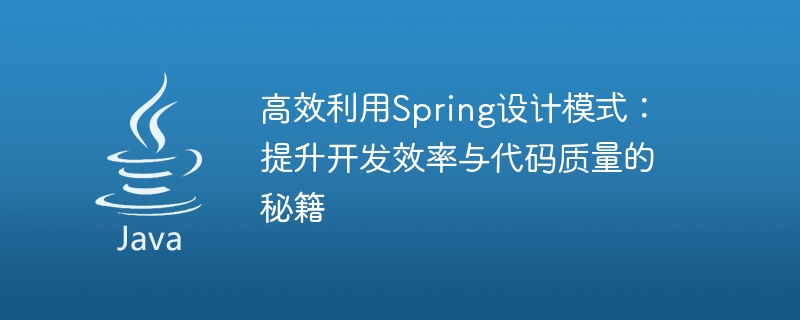Home >Java >javaTutorial >Secrets to improve development efficiency and code quality: effective application of Spring design patterns
Secrets to improve development efficiency and code quality: effective application of Spring design patterns
- WBOYOriginal
- 2023-12-30 08:08:44816browse

Efficient use of Spring design patterns: secrets to improve development efficiency and code quality
Introduction:
Spring is a lightweight open source Java framework that is widely used Applied to the development of enterprise-level Java applications. Its design patterns and features can improve development efficiency and reduce code redundancy and maintenance costs. This article aims to introduce some commonly used Spring design patterns and how to use them to improve development efficiency and code quality.
1. Singleton pattern
The singleton pattern is a classic design pattern that is widely used in Spring. Its role is to ensure that a class has only one instance and provide a global access point. Spring manages the life cycle of beans through the container. You can declare a class as a singleton and inject it where needed.
Code example:
@Service
public class SingletonDemo {
// 私有的静态实例
private static SingletonDemo instance;
// 私有构造方法
private SingletonDemo() {}
// 全局访问点
public static SingletonDemo getInstance() {
if (instance == null) {
instance = new SingletonDemo();
}
return instance;
}
} 2. Factory pattern
The factory pattern is a creational design pattern that creates objects through factory classes and separates the creation and use of objects. . In Spring, you can use the factory pattern to create and manage Bean objects.
Code example:
public interface Car {
void drive();
}
@Component
public class BMW implements Car {
public void drive() {
System.out.println("Driving BMW");
}
}
@Component
public class Audi implements Car {
public void drive() {
System.out.println("Driving Audi");
}
}
@Component
public class CarFactory {
public Car createCar(String brand) {
if ("BMW".equals(brand)) {
return new BMW();
} else if ("Audi".equals(brand)) {
return new Audi();
} else {
throw new IllegalArgumentException("Invalid brand: " + brand);
}
}
} 3. Proxy pattern
The proxy pattern is a structural design pattern that controls access to original objects through proxy classes. In Spring, the proxy mode can be used to implement transaction management, logging and other functions.
Code example:
public interface UserService {
void saveUser(User user);
}
@Service
public class UserServiceImpl implements UserService {
@Override
public void saveUser(User user) {
// 保存用户逻辑
}
}
@Component
public class UserServiceProxy implements UserService {
@Autowired
private UserServiceImpl userService;
@Override
public void saveUser(User user) {
// 执行额外的逻辑,如事务的开始和提交
userService.saveUser(user);
// 执行额外的逻辑,如日志的记录
}
}Conclusion:
Spring design pattern is an important tool to improve development efficiency and code quality. Through the singleton pattern, we can ensure that a class has only one instance; through the factory pattern, we can dynamically generate objects; through the proxy pattern, we can realize the function of cross-cutting concerns. The comprehensive application of these design patterns can make our code more modular, maintainable and expandable. I hope this article can help everyone make better use of Spring design patterns and improve development efficiency and code quality.
The above is the detailed content of Secrets to improve development efficiency and code quality: effective application of Spring design patterns. For more information, please follow other related articles on the PHP Chinese website!
Related articles
See more- Python uses IPython to improve development efficiency
- Advanced VSCode extension that improves JavaScript development efficiency!
- Practical vscode plug-in to improve development efficiency (share)
- 30 VSCode plug-ins to improve PHP development efficiency
- Some commonly used plug-ins and shortcut keys in VSCode can help you improve development efficiency! !

